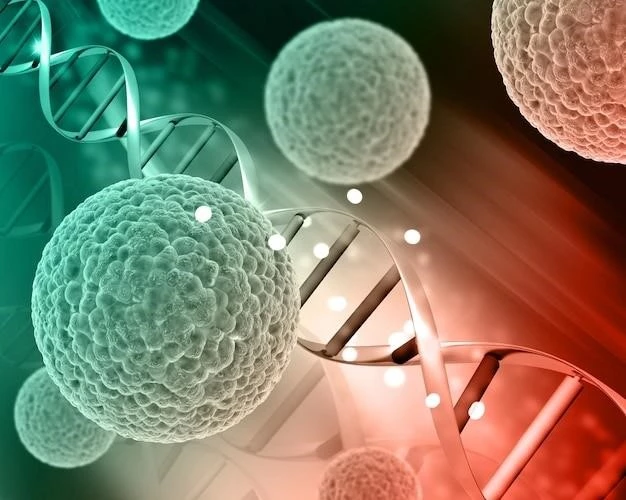Understanding Leukemia
Leukemia is a type of blood cancer that affects the white blood cells produced in the bone marrow, mainly the lymphocytes․ To fully understand this disease, we will cover its overview, causes, symptoms, diagnosis, treatment options, prognosis, and lifestyle changes․
Overview of Leukemia
Leukemia is a type of blood cancer that affects the white blood cells, particularly the lymphocytes․ These abnormal cells crowd out the healthy blood cells, leading to various complications․ There are different types of leukemia, including acute and chronic forms that can affect children and adults․ Symptoms may include fatigue, frequent infections, easy bruising, and swollen lymph nodes․
Leukemia can be classified based on the speed of progression and the type of white blood cell affected․ The exact cause is not always clear, but factors like genetic mutations, exposure to radiation or certain chemicals, and a weakened immune system can increase the risk․ Diagnosis typically involves blood tests, bone marrow biopsy, and imaging studies․
Treatment options for leukemia include chemotherapy, radiation therapy, targeted therapy, immunotherapy, and stem cell transplant․ The choice of treatment depends on the type of leukemia, its stage, and the patient’s overall health․ Prognosis varies but advancements in medical science have significantly improved survival rates in recent years․
Understanding leukemia is crucial for patients and their families to make informed decisions about treatment and lifestyle changes․ It is essential to work closely with healthcare professionals to manage the disease effectively and maintain a good quality of life․ Support groups and counseling can also provide emotional support during this challenging time․
Causes and Symptoms
The exact cause of leukemia is not always clear, but several risk factors can increase the likelihood of developing this type of cancer․ These risk factors include genetic mutations, exposure to high levels of radiation, certain chemicals like benzene, smoking, and a weakened immune system․ In some cases, a family history of leukemia may also play a role․
It’s important to be aware of the common symptoms of leukemia, which can vary depending on the type of leukemia and the stage of the disease․ Common symptoms include fatigue, shortness of breath, frequent infections, easy bruising or bleeding, weight loss, swollen lymph nodes, and night sweats․ If you experience persistent symptoms, it’s important to consult a healthcare professional for an accurate diagnosis․
Early detection of leukemia is crucial for better treatment outcomes․ If you notice any concerning symptoms or have risk factors for leukemia, do not hesitate to seek medical attention․ A timely diagnosis can lead to prompt initiation of treatment and improved prognosis․ Remember, proactive management of symptoms and early intervention are key in the fight against leukemia․

Diagnosis of Leukemia
Diagnosing leukemia involves a series of tests to confirm the presence of abnormal white blood cells and determine the type and stage of the disease․ Common diagnostic tests include blood tests to check for the number and appearance of blood cells, bone marrow biopsy to examine the marrow for leukemia cells, and imaging studies like X-rays, CT scans, or ultrasounds to assess the spread of the disease․
If you are experiencing symptoms of leukemia or have risk factors for the disease, it’s essential to consult a hematologist or oncologist for a comprehensive evaluation․ These specialists have the expertise to interpret test results and recommend further investigations if needed․ Early diagnosis is key to initiating timely treatment and improving outcomes․
During the diagnostic process, your healthcare team will work with you to understand your medical history, perform a physical examination, and conduct the necessary tests to confirm or rule out leukemia․ It’s important to communicate openly with your healthcare provider, ask questions about the diagnostic process, and follow their recommendations for further evaluation․
Treatment Options
There are several treatment options available for leukemia, depending on the type of leukemia, its stage, and the patient’s overall health․ Common treatment approaches include chemotherapy, which uses drugs to target and kill cancer cells, radiation therapy to destroy cancer cells using high-energy rays, targeted therapy to focus on specific abnormalities in cancer cells, immunotherapy to enhance the body’s immune response against cancer, and stem cell transplant to replace diseased bone marrow with healthy stem cells․
It is crucial to work closely with a multidisciplinary healthcare team, including hematologists, oncologists, and other specialists, to develop a personalized treatment plan․ Each treatment option has its benefits and potential side effects, so discussing these with your healthcare team and understanding the implications can help you make informed decisions about your care․
Adhering to the treatment plan outlined by your healthcare provider, attending regular follow-up appointments, and monitoring your response to treatment are essential steps in managing leukemia effectively․ It’s important to communicate any concerns or side effects to your healthcare team promptly so that adjustments can be made to optimize your treatment outcomes․
Prognosis and Recovery
The prognosis for leukemia varies depending on factors such as the type of leukemia, the stage at diagnosis, the patient’s age and overall health, and the response to treatment․ Advances in medical research and treatment have significantly improved survival rates for many individuals with leukemia in recent years․
It’s important to stay informed about your specific type of leukemia, understand your treatment plan, and actively participate in your care to improve your prognosis․ Regular follow-up appointments, monitoring for any signs of recurrence, and maintaining a healthy lifestyle can all contribute to a better long-term outcome․
Recovery from leukemia is a journey that can be physically and emotionally challenging․ It’s essential to seek support from healthcare professionals, family, friends, and support groups to navigate this process․ Remember to take care of your mental health during treatment and recovery, as emotional well-being plays a significant role in overall health․
Lifestyle Changes and Support
Living with leukemia may require making certain lifestyle changes to support your overall health and well-being․ It’s essential to maintain a nutritious diet rich in fruits, vegetables, whole grains, and lean proteins to support your immune system and overall health․ Staying hydrated, getting regular exercise as recommended by your healthcare provider, and managing stress through techniques like mindfulness or relaxation exercises can also be beneficial․
As you navigate your leukemia diagnosis and treatment, it’s important to seek support from your healthcare team, loved ones, and support groups․ Having a strong support system can provide emotional encouragement, practical assistance, and valuable information throughout your journey․ Don’t hesitate to reach out for help when needed, whether it’s for physical, emotional, or practical support․
Remember to communicate openly with your healthcare team about any concerns, side effects, or questions you may have regarding your treatment or recovery․ Engaging in open and honest conversations with your healthcare providers can help you feel more empowered and informed about your care․ By prioritizing self-care, seeking support, and staying engaged in your treatment plan, you can navigate the challenges of leukemia with resilience and strength;
